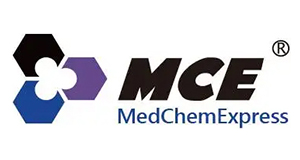EIPA, CAS 1154-25-2
EIPA, CAS 1154-25-2
SKU
MEXHY-101840-25
Packaging Unit
25 mg
Manufacturer
MedChemExpress
Availability:
loading...
Price is loading...
Product Description: EIPA (L593754) is an orally active TRPP3 channel inhibitor with an IC50 of 10.5 μM. EIPA also enhances autophagy by inhibiting Na+/H+-exchanger 3 (NHE3). EIPA inhibits macropinocytosis as well. EIPA can be used in the research of inflammation and cancers, such as gastric cancer, colon carcinoma, pancreatic carcinoma[1][2][3][4][5][6][7].
Applications: Cancer-programmed cell death
Formula: C11H18ClN7O
Citations: ACS Appl Mater Interfaces. 2020 Oct 14;12(41):45763-45771./ACS Nano. 2020 Nov 24;14(11):14698-14714./ACS Nano. 2024 Sep 11./Adv Funct Mater. 2021 Apr 1./Adv Mater. 2025 Jan 10:e2415030./Adv Sci (Weinh). 2024 Nov 6:e2412014./Anal Chem. 2020 Jan 21;92(2):2103-2111./Autophagy. 2022 Aug 1;1-19./BBA-Gen Subjects. 2022: 130300./Biol Open. 2023 Oct 5:bio.060081./Biomacromolecules. 2021 Aug 12./Biomaterials. 13 January 2022, 121373./Bioorg Chem. 2022 Feb 12;121:105651./bioRxiv. 2024 Jan 11./Biotechnol J. 2022 Nov 2;e2200393/BMC Plant Biol. 2025 Feb 7;25(1):159./Carcinogenesis. 2024 Jul 15:bgae045./Cell Metab. 2022 Dec 6;34(12):2018-2035.e8./Chem Eng J. 2024 Sep 1./Clin Transl Med. 2025 Jan;15(1):e70191./Comput Struct Biotec. 2021;19:1933-1943./Drug Deliv. 2021 Dec;28(1):800-813./Exp Hematol. 2024 Oct 1:104651./Genes Dev. 2021 Oct 1;35(19-20):1327-1332./iScience. 2023 Mar 30./J Biol Chem. 19 September 2022, 102511./J Control Release. 2022 Oct 7;351:703-712./J Control Release. 2023 Feb 17;355:675-684./J Control Release. 2024 Apr 24:370:140-151./J Exp Med. 2023 Mar 6;220(3):e20221316./J Hazard Mater. 2021 Sep 5;417:126092./J Nanobiotechnology. 2022 Jun 10;20(1):268./J Neuroinflammation. 2024 May 10;21(1):125./J Pathol. 2023 Jan 30. doi: 10.1002/path.6059./J Virol. 2021 Sep 29;JVI0134521./Matter. 2023 Aug 31./Microvasc Res. 2021, 104219./Nanotoxicology. 2023 Jan 26;1-18./Nat Commun. 2024 Jan 2;15(1):162./Nat Commun. 2025 Feb 4;16(1):1327./Nat Nanotechnol. 2024 Oct 28./Pharmaceutics. 2020 Feb 17;12(2):167./Pharmaceutics. 2024 Nov 21./PLoS Pathog. 2024 Nov 21;20(11):e1012681./Sci Adv. 2020 Aug 12;6(33):eaaz1774./Sci China Life Sci. 2021 May 27;1-21./Sci China Mater. 63, 620-628 (2020)./Theranostics. 2022 Jan 1;12(3):1061-1073./Vet Res. 2023 Mar 14;54(1):24./Viruses. 2021 May 31;13(6):1035./Acta Biomater. 2023 Dec 18:S1742-7061(23)00724-9./Emerg Microbes Infect. 2022 Dec;11(1):1135-1144./J Nanobiotechnology. 2022 Jul 20;20(1):340./Mol Pharm. 2021 Sep 7.
References: [1]Dai XQ, et al. Inhibition of TRPP3 channel by MK-870 and analogs. Mol Pharmacol. 2007 Dec;72(6):1576-85./[2]Shi H, et al. Na+/H+ Exchanger Regulates Amino Acid-Mediated Autophagy in Intestinal Epithelial Cells. Cell Physiol Biochem. 2017;42(6):2418-2429./[3]Zhu BY, et al. A new HDAC inhibitor cinnamoylphenazine shows antitumor activity in association with intensive macropinocytosis./[4]E V Stelmashook, et al. Acidosis and 5-(N-ethyl-N-isopropyl)amiloride (EIPA) Attenuate Zinc/Kainate Toxicity in Cultured Cerebellar Granule Neurons. Biochemistry (Mosc). 2015 Aug;80(8):1065-72. /[5]Shigekuni Hosogi, et al. An inhibitor of Na(+)/H(+) exchanger (NHE), ethyl-isopropyl amiloride (EIPA), diminishes proliferation of MKN28 human gastric cancer cells by decreasing the cytosolic Cl(-) concentration via DIDS-sensitive pathways. Cell Physiol Biochem. 2012;30(5):1241-53./[6]Junji Yamashita, et al. Role of Na+/H+ exchanger in the pathogenesis of ischemic acute renal failure in mice. J Cardiovasc Pharmacol. 2007 Mar;49(3):154-60. /[7]Fumitaka Kamachi, et al. Inhibition of lipopolysaccharide-induced prostaglandin E2 production and inflammation by the Na+/H+ exchanger inhibitors. J Pharmacol Exp Ther. 2007 Apr;321(1):345-52.
CAS Number: 1154-25-2
Molecular Weight: 299.76
Compound Purity: 99.73
Research Area: Cancer; Inflammation/Immunology
Solubility: DMSO : 50 mg/mL (ultrasonic)/H2O : < 0.1 mg/mL (ultrasonic)
Target: Autophagy;COX;Na+/H+ Exchanger (NHE);Prostaglandin Receptor;TRP Channel
Applications: Cancer-programmed cell death
Formula: C11H18ClN7O
Citations: ACS Appl Mater Interfaces. 2020 Oct 14;12(41):45763-45771./ACS Nano. 2020 Nov 24;14(11):14698-14714./ACS Nano. 2024 Sep 11./Adv Funct Mater. 2021 Apr 1./Adv Mater. 2025 Jan 10:e2415030./Adv Sci (Weinh). 2024 Nov 6:e2412014./Anal Chem. 2020 Jan 21;92(2):2103-2111./Autophagy. 2022 Aug 1;1-19./BBA-Gen Subjects. 2022: 130300./Biol Open. 2023 Oct 5:bio.060081./Biomacromolecules. 2021 Aug 12./Biomaterials. 13 January 2022, 121373./Bioorg Chem. 2022 Feb 12;121:105651./bioRxiv. 2024 Jan 11./Biotechnol J. 2022 Nov 2;e2200393/BMC Plant Biol. 2025 Feb 7;25(1):159./Carcinogenesis. 2024 Jul 15:bgae045./Cell Metab. 2022 Dec 6;34(12):2018-2035.e8./Chem Eng J. 2024 Sep 1./Clin Transl Med. 2025 Jan;15(1):e70191./Comput Struct Biotec. 2021;19:1933-1943./Drug Deliv. 2021 Dec;28(1):800-813./Exp Hematol. 2024 Oct 1:104651./Genes Dev. 2021 Oct 1;35(19-20):1327-1332./iScience. 2023 Mar 30./J Biol Chem. 19 September 2022, 102511./J Control Release. 2022 Oct 7;351:703-712./J Control Release. 2023 Feb 17;355:675-684./J Control Release. 2024 Apr 24:370:140-151./J Exp Med. 2023 Mar 6;220(3):e20221316./J Hazard Mater. 2021 Sep 5;417:126092./J Nanobiotechnology. 2022 Jun 10;20(1):268./J Neuroinflammation. 2024 May 10;21(1):125./J Pathol. 2023 Jan 30. doi: 10.1002/path.6059./J Virol. 2021 Sep 29;JVI0134521./Matter. 2023 Aug 31./Microvasc Res. 2021, 104219./Nanotoxicology. 2023 Jan 26;1-18./Nat Commun. 2024 Jan 2;15(1):162./Nat Commun. 2025 Feb 4;16(1):1327./Nat Nanotechnol. 2024 Oct 28./Pharmaceutics. 2020 Feb 17;12(2):167./Pharmaceutics. 2024 Nov 21./PLoS Pathog. 2024 Nov 21;20(11):e1012681./Sci Adv. 2020 Aug 12;6(33):eaaz1774./Sci China Life Sci. 2021 May 27;1-21./Sci China Mater. 63, 620-628 (2020)./Theranostics. 2022 Jan 1;12(3):1061-1073./Vet Res. 2023 Mar 14;54(1):24./Viruses. 2021 May 31;13(6):1035./Acta Biomater. 2023 Dec 18:S1742-7061(23)00724-9./Emerg Microbes Infect. 2022 Dec;11(1):1135-1144./J Nanobiotechnology. 2022 Jul 20;20(1):340./Mol Pharm. 2021 Sep 7.
References: [1]Dai XQ, et al. Inhibition of TRPP3 channel by MK-870 and analogs. Mol Pharmacol. 2007 Dec;72(6):1576-85./[2]Shi H, et al. Na+/H+ Exchanger Regulates Amino Acid-Mediated Autophagy in Intestinal Epithelial Cells. Cell Physiol Biochem. 2017;42(6):2418-2429./[3]Zhu BY, et al. A new HDAC inhibitor cinnamoylphenazine shows antitumor activity in association with intensive macropinocytosis./[4]E V Stelmashook, et al. Acidosis and 5-(N-ethyl-N-isopropyl)amiloride (EIPA) Attenuate Zinc/Kainate Toxicity in Cultured Cerebellar Granule Neurons. Biochemistry (Mosc). 2015 Aug;80(8):1065-72. /[5]Shigekuni Hosogi, et al. An inhibitor of Na(+)/H(+) exchanger (NHE), ethyl-isopropyl amiloride (EIPA), diminishes proliferation of MKN28 human gastric cancer cells by decreasing the cytosolic Cl(-) concentration via DIDS-sensitive pathways. Cell Physiol Biochem. 2012;30(5):1241-53./[6]Junji Yamashita, et al. Role of Na+/H+ exchanger in the pathogenesis of ischemic acute renal failure in mice. J Cardiovasc Pharmacol. 2007 Mar;49(3):154-60. /[7]Fumitaka Kamachi, et al. Inhibition of lipopolysaccharide-induced prostaglandin E2 production and inflammation by the Na+/H+ exchanger inhibitors. J Pharmacol Exp Ther. 2007 Apr;321(1):345-52.
CAS Number: 1154-25-2
Molecular Weight: 299.76
Compound Purity: 99.73
Research Area: Cancer; Inflammation/Immunology
Solubility: DMSO : 50 mg/mL (ultrasonic)/H2O : < 0.1 mg/mL (ultrasonic)
Target: Autophagy;COX;Na+/H+ Exchanger (NHE);Prostaglandin Receptor;TRP Channel
| SKU | MEXHY-101840-25 |
|---|---|
| Manufacturer | MedChemExpress |
| Manufacturer SKU | HY-101840-25 |
| Package Unit | 25 mg |
| Quantity Unit | STK |
| Product information (PDF) |
|
| MSDS (PDF) |
|

 Deutsch
Deutsch










